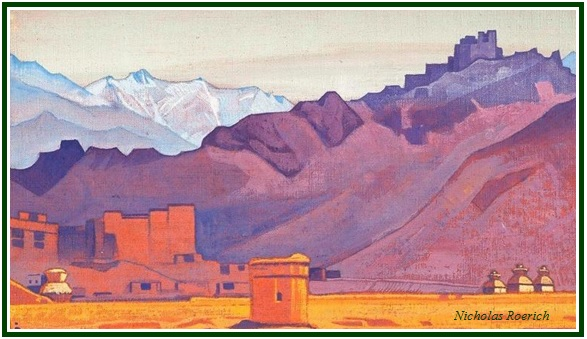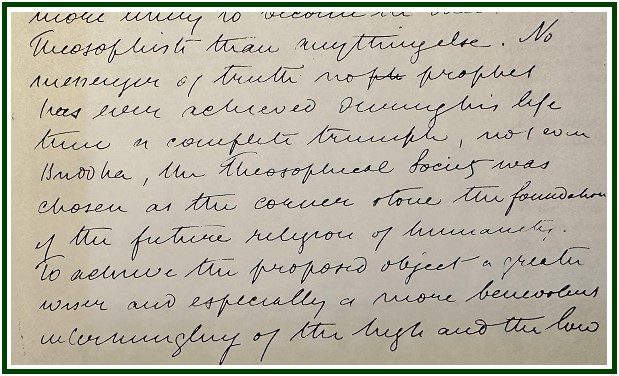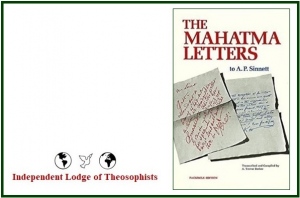
A Key to Understand the Future
A Mahatma of the Himalayas

1. Introduction: the Importance of the Document
Historical records show us that in 1881 one of the Masters of the Wisdom who directly guided the Theosophical work in its pioneering phase decided to seek advice, and consulted his own teacher.
The Master of Masters was then heard. The topic was the nature, the goal and the direction of the movement that was being started.
The sage who was consulted is called by the Masters simply Chohan. The word “Chohan” means “Lord”. Since then, this same Sage has often referred to as “Maha-Chohan”. One of H. P. Blavatsky’s teachers once called him “the rock of the ages”. At another point, this Eastern sage referred to the Chohan as “the one for whom the future is like an open page”. [1]
After the consultation with the Maha-Chohan, the Master gave an account of the conversation. This text is the most authoritative description of the Mission that should be fulfilled by the authentic theosophical and esoteric movement, not only in the following decades, but also in the following centuries. It contains an extraordinary and encouraging prophecy about the cultural and historical progress of our humanity. Unlike so many “prophecies” that limit themselves to announcing disasters, the text points the way to the victorious human transition (not without sacrifices) to a new era of planetary fraternity.
The Letter of the Maha-Chohan has special importance – among other reasons – because we find in it central elements of information about the religion of the future. It defines the general lines of a religiosity that should become more visible during the 21st century. There was, however, a doubt regarding the exact content of the letter in a decisive passage. The text transcribed by C. Jinarajadasa in the volume “Letters From the Masters of Wisdom – first series” says:
“The Theosophical Society was chosen as the corner-stone, the foundation of the future religions of humanity”. [2]
The passage may lead the student to a few questions. Will there be, in the future, several religions competing with each other? Or will there be a single global religion, which will have, however, a non-authoritarian character?
The original of the Letter of the Maha-Chohan disappeared, and there is more than one copy of it. In the early years of the movement, transcriptions of the Letters of the Mahatmas were privately circulated among students. The Pasadena Theosophical Society published the version of the text that can be seen in the British Library. In it, the document refers to the future religion, in the singular form:
“The Theosophical Society was chosen as the corner-stone, the foundation of the future religion of humanity”. [3]
In this case, the Master would have stated that the religion of the future will be only one – naturally not in the bureaucratic sense of the word, for it will inevitably welcome cultural diversity.
In order to directly check and verify the facts, we took steps to obtain an authentic copy of the most authoritative version of the Letter of the Chohan that exists in the world. This is, no doubt, the copy made in pen by Alfred Sinnett himself, the British journalist and theosophist who received it from the Master. The document is now in the Additional Manuscripts sector of the British Library, in London, under the title of Mahatma Papers. Its shelfmark identification is ADD.45289A. In May 2009, a complete certified copy of manuscript ADD.45289A was obtained from the British Library.
Direct examination of the letter, on page 53 of Sinnett’s manuscript, confirms the fact that the correct sentence is:
“The Theosophical Society was chosen as the corner-stone, the foundation of the future religion of humanity.”

Partial view of Sinnett’s transcription of the lettter, with the words “of the future religion”
Such a confirmation is important for several reasons. One of them is that even today most theosophical publications – including those focused on original theosophy – continue to publish the erroneous version of the sentence, which refers to “religions”, in the plural, as in C. Jinarajadasa’s version.
It is also important to note that, in the last sentence of the letter, there is a reference to “the true philosophy, the true religion, the true light”, in the singular form.
The religion of the future is a philosophical religion, a wisdom-religion.
It is only one, which means universal, but it is not authoritarian, and therefore it includes the principle of diversity. It is based on the direct perception and experience of the law of brotherhood that unites all beings. Internally one, it can be seen as externally multiple.
We transcribe below the full text of the prophetic Letter of the Maha-Chohan, in Jinarajadasa’s version, with the correction in the sentence referring to the religion of the future.
(Carlos Cardoso Aveline)
2. The Complete Letter of the Maha-Chohan

Original title and opening lines of the letter, in the copy made by A. P. Sinnett
Several Good Reasons Why the T.S.
Should be a Brotherhood of Mankind
For the Simla Eclectic T.S.
The doctrine we promulgate being the only true one, must, supported by such evidence as we are preparing to give become ultimately triumphant as every other truth. Yet it is absolutely necessary to inculcate it gradually, enforcing its theories, unimpeachable facts for those who know, with direct inferences deduced from and corroborated by the evidence furnished by modern exact science. That is the reason why Colonel H.S.O., who works but to revive Buddhism, may be regarded as one who labours in the true path of theosophy, far more than any other man who chooses as his goal the gratification of his own ardent aspirations for occult knowledge. Buddhism stripped of its superstitions is eternal truth, and he who strives for the latter is striving for Theo-Sophia, Divine Wisdom, which is a synonym of truth.
For our doctrines to practically react on the so-called moral code, or the ideas of truthfulness, purity, self-denial, charity, etc., we have to popularise a knowledge of theosophy. It is not the individual and determined purpose of attaining oneself Nirvana (the culmination of all knowledge and absolute wisdom) which is, after all only an exalted and glorious selfishness -but the self-sacrificing pursuit of the best means to lead on the right path our neighbour, to cause as many of our fellow-creatures as we possibly can to benefit by it, which constitutes the true theosophist.
The intellectual portions of mankind seem to be fast drifting into two classes, the one unconsciously preparing for itself long periods of temporary annihilation or states of non-consciousness, owing to the deliberate surrender of their intellect, its imprisonment in the narrow grooves of bigotry and superstition, a process which cannot fail to lead to the utter deformation of the intellectual principle; the other unrestrainedly indulging its animal propensities with the deliberate intention of submitting to annihilation pure and simple in case of failure, to millenniums of degradation after physical dissolution. Those “intellectual classes”, reacting upon the ignorant masses which they attract and which look up to them as noble and fit examples to follow, degrade and morally ruin those they ought to protect and guide. Between degrading superstition and still more degrading brutal materialism, the white dove of truth has hardly room where to rest her weary unwelcome foot.
It is time that Theosophy should enter the arena; the sons of theosophists are more likely to become in their turn theosophists than anything else. No messenger of truth, no prophet has ever achieved during his life time a complete triumph, not even Buddha. The Theosophical Society was chosen as the corner-stone, the foundation of the future religion of humanity. To achieve the proposed object, a greater, wiser, and especially a more benevolent intermingling of the high and the low, of the Alpha and the Omega of society, was determined upon. The white race must be the first to stretch out the hand of fellowship to the dark nations, to call the poor despised “nigger” brother. This prospect may not smile to all, but he is no Theosophist who objects to this principle.
In view of the ever-increasing triumph and at the same time misuse of free-thought and liberty (the universal reign of Satan, Eliphas Levi would have called it), how is the combative natural instinct of man to be restrained from inflicting hitherto unheard-of cruelty and enormities, tyranny, injustice, etc., if not through the soothing influence of a brotherhood, and of the practical application of Buddha’s esoteric doctrines?
For as everyone knows, total emancipation from authority of the one all-pervading power or law called God by the priests – Buddha, Divine Wisdom and enlightenment or Theosophy by the philosophers of all ages – means also the emancipation from that of human law. Once unfettered and delivered from their dead-weight of dogmatic interpretations, personal names, anthropomorphic conceptions and salaried priests, the fundamental doctrines of all religions will be proved identical in their esoteric meaning. Osiris, Chrishna, Buddha, Christ, will be shown as different names for one and the same royal highway to final bliss Nirvana.
Mystical Christianity, that is to say that Christianity which teaches self-redemption through our own seventh principle – this liberated Para-Atma (Augoeides) called by the some Christ, by others Buddha, and equivalent to regeneration or rebirth in spirit – will be found just the same truth as the Nirvana of Buddhism. All of us have to get rid of our own Ego, the illusory apparent self, to recognise our true self in a transcendental divine life. But if we would not be selfish, we must strive to make other people see that truth, to recognise the reality of that transcendental self, the Buddha, the Christ or God of every preacher. This is why even exoteric Buddhism is the surest path to lead men towards the one esoteric truth.
As we find the world now, whether Christian, Mussulman or Pagan, justice is disregarded and honour and mercy both flung to the winds. In a word, how, seeing that the main objects of the T.S. are misinterpreted by those who are most willing to serve us personally, are we to deal with the rest of mankind, with the curse known as the “struggle for life”, which is the real and most prolific parent of most woes and sorrows and all crimes? Why has that struggle become the almost universal scheme of the universe? We answer, because no religion, with the exception of Buddhism, has hitherto taught a practical contempt for this earthly life, while each of them, always with that one solitary exception, has through its hells and damnations inculcated the greatest dread of death. Therefore do we find that struggle for life raging most fiercely in Christian countries, most prevalent in Europe and America. It weakens in the Pagan lands and is nearly unknown among Buddhist populations. (In China during famine and where the masses are most ignorant of their own or any religion, it was remarked that those mothers who devoured their children belonged to localities where there were the most of Christian missionaries to be found; where there were none, and the Bonzes alone had the field, the population died with the utmost indifference.) Teach the people to see that life on this earth even the happiest is but a burden and an illusion, that it is but our own Karma, the cause producing the effect that is our own judge, our saviour in future lives, and the great struggle for life will soon lose its intensity. There are no penitentiaries in Buddhist lands, and crime is nearly unknown among the Buddhist Thibetans. (The above is not addressed to you, i.e., A.P.S., and has naught to do with the work of the Simla Eclectic Society. It is meant only as an answer to the erroneous impression in Mr. Hume’s mind of the “Ceylon work” as no theosophy.)
The world in general, and Christendom especially, left for two thousand years to the regime of a personal God, as well as its political and social systems based on that idea, has now proved a failure. If the Theosophists say: “We have nothing to do with all this; the lower classes and the inferior races (those of India for instance in the conception of the British) cannot concern us and must manage as they can”, what becomes of our fine professions of benevolence, philanthropy, reform, etc.? Are these professions a mockery? And if a mockery, can ours be the true path? Shall we not devote ourselves to teaching a few Europeans, fed on the fat of the land, many of them loaded with the gifts of blind fortune, the rationale of bell-ringing, cup-growing, of the spiritual telephone and astral body formations, and leave the teeming millions of the ignorant, of the poor and despised, the lowly and the oppressed, to take care of themselves and of their hereafter as best they know how? Never. Rather perish the T.S. with both its hapless founders than that we should permit it to become no better than an academy of magic, a hall of occultism. That we the devoted followers of that spirit incarnate of absolute self-sacrifice, of philanthropy, divine kindness, as of all the highest virtues attainable on this earth of sorrow, the man of men, Gautama Buddha, should ever allow the T.S. to represent the embodiment of selfishness, the refuge of the few with no thought in them for the many, is a strange idea, my brothers.
Among the few glimpses obtained by Europeans of Thibet and its mystical hierarchy of “perfect Lamas”, there is one which was correctly understood and described. “The incarnations of the Boddisattva, Padma Pani or Avalokitesvara and of Tsong-ka-pa and that of Amitabha, relinquish at their death the attainment of Buddhahood – i.e., the summum bonum of bliss and of individual personal felicity – that they might be born again and again for the benefit of mankind.” (R.D.)[4] In other words, that they might be again and again subjected to misery, imprisonment in flesh, and all the sorrows of life, provided that by such a self-sacrifice, repeated throughout long and dreary centuries, they might become the means of securing salvation and bliss in the hereafter for a handful of men chosen among but one of the many races of mankind. And it is we, the humble disciples of these perfect Lamas, who are expected to allow the T.S. to drop its noble title, that of the Brotherhood of Humanity, to become a simple school of psychology. No, no, good brothers, you have been labouring under the mistake too long already. Let us understand each other. He who does not feel competent enough to grasp the noble idea sufficiently, to work for it, need not undertake a task too heavy for him. But there is hardly a Theosophist in the whole society unable to effectually help it by correcting the erroneous impressions of the outsiders, if not by actually propagating himself the idea. Oh, for the noble and unselfish man to help us effectually in India in that divine task. All our knowledge, past and present, would not be sufficient to repay him.
Having explained our views and aspirations, I have but a few words more to add. To be true, religion and philosophy must offer the solution of every problem. That the world is in such a bad condition morally is a conclusive evidence that none of its religions and philosophies, those of the civilised races less than any other, have ever possessed the truth. The right and logical explanations on the subject of the problems of the great dual principles – right and wrong, good and evil, liberty and despotism, pain and pleasure, egotism and altruism – are as impossible to them now as they were 1881 years ago. They are as far from the solution as they ever were; but to these there must be somewhere a consistent solution, and if our doctrines will prove their competence to offer it, then the world will be quick to confess that must be the true philosophy, the true religion, the true light, which gives truth and nothing but the truth.
NOTES:
[1] Regarding the reference to the future being “like an open page”, see “Letters From the Masters of the Wisdom – First Series”, letter 16, to H.S. Olcott, page 45, upper half. On the reference to the Chohan being “the Rock of Ages”, see “The Mahatma Letters”, Letter IX, first paragraph, page 38. (CCA)
[2] Letter 01 in “Letters From the Masters of the Wisdom – First Series”. See the lower half of page 04. (CCA)
[3] “View of the Chohan on the T.S.”, a text included in the volume “Combined Chronology – For use with ‘The Mahatma Letters to A.P. Sinnett’ and ‘The Letters of H.P.B. To A.P. Sinnett’”, by Margaret Conger, T.U.P., Pasadena, California, USA, 1973, 48 pp., see especially page 44. (CCA)
[4] Rhys Davids. (Note by C. Jinarajadasa, the editor of “Letters From the Masters of the Wisdom – First Series”)
000
The above text was published as a separate item in the websites of the Independent Lodge of Theosophists on 20 November 2023. It is also part of the November 2023 edition of “The Aquarian Theosophist”.
000
Note by the Editors
The fact is widely recognized that the text “The Letter of the Maha-Chohan” can be considered the inner Charter of the theosophical movement. According to the Independent Lodge of Theosophists, the direct teachings of the Masters of the Wisdom constitute the most important part of the theosophical literature.
000
Read more:
000
